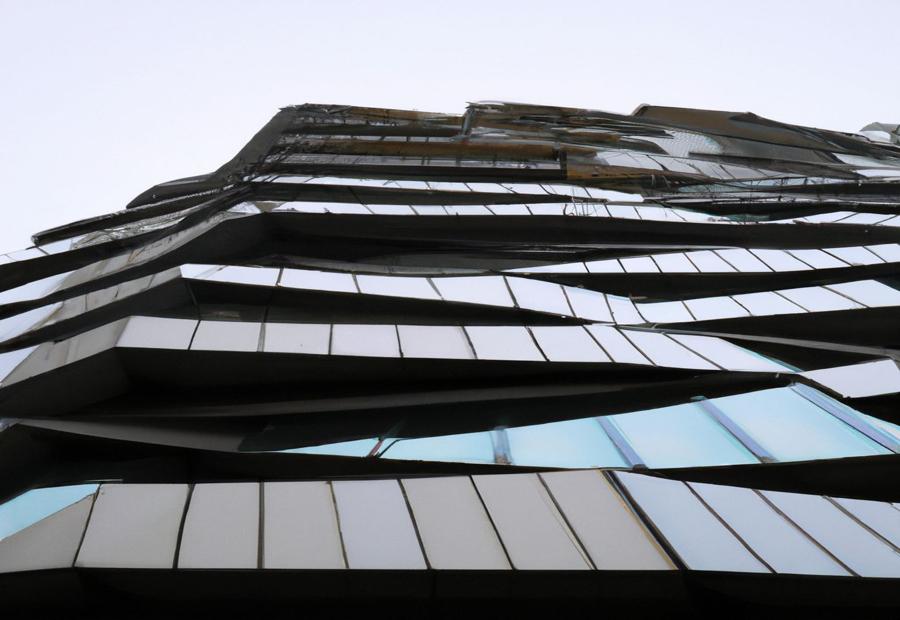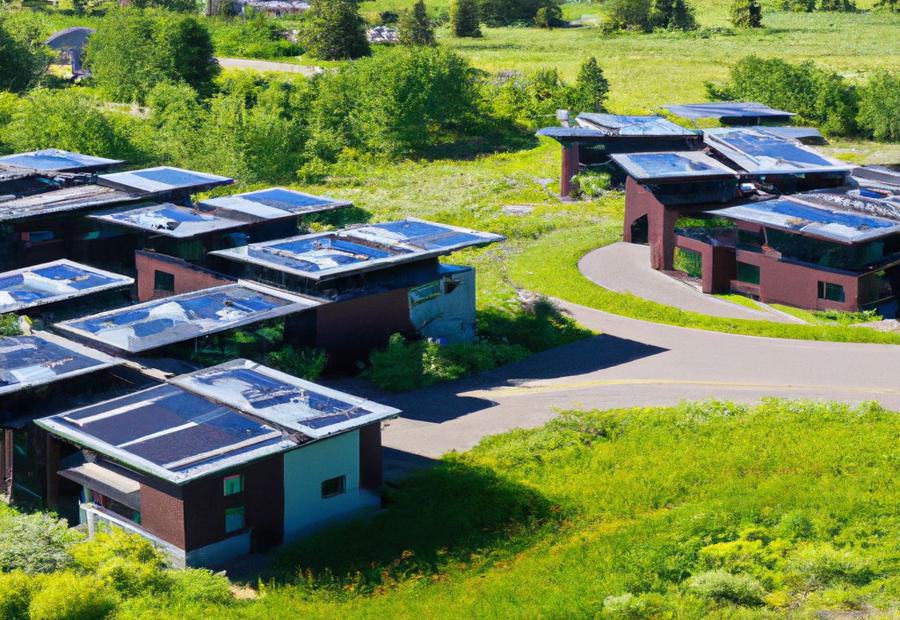Key Takeaway:
- Using sustainable materials in construction projects is important for practicing sustainability and reducing the environmental impact.
- The benefits of using sustainable materials include resource efficiency, reduced pollution, significant cost savings, improved water efficiency, lower building maintenance, improved indoor air quality, and conservation of resources.



Photo Credits: Build-Wire.Com by Justin Young
In construction projects, the use of sustainable materials offers a wide range of benefits. From promoting eco-conscious practices to minimizing the environmental impact, the advantages are significant. In this introduction, we will explore the importance of sustainable practices and delve into the environmental benefits that arise from utilizing sustainable materials in construction. Let’s discover how incorporating these materials can revolutionize the way we build, ensuring a more sustainable and greener future.
Importance Of Sustainable Practices
Sustainable practices are vital in the construction industry. This is because they prioritize the long-term effects of projects on the environment, economy and people. By using sustainable practices, construction companies can decrease their carbon footprint and conserve natural resources for future generations.
Using sustainable materials in construction has many advantages. Firstly, it helps to utilize renewable or readily available materials, decreasing the use of finite resources and lessening waste generation during construction. Moreover, it lowers pollution by decreasing the emission of harmful substances into the environment, thereby improving air and water quality.
Using sustainable materials can also provide monetary benefits. Sustainable materials are usually more resilient and require less maintenance, resulting in lower building maintenance costs. Additionally, sustainable buildings have improved water efficiency through features such as rainwater harvesting systems and low-flow fixtures, which cuts down on water consumption.
The use of sustainable materials also increases indoor air quality. Traditional construction materials contain volatile organic compounds (VOCs) that are hazardous to people’s health. Sustainable materials, however, emit fewer VOCs, creating a healthier indoor atmosphere.
Moreover, utilizing sustainable materials contributes to conserving natural resources. For example, using dimensioned lumber boards made from reclaimed wood reduces the demand for newly harvested timber.
Government policies are increasingly supporting sustainability in the construction industry. Companies are, therefore, incentivized to adopt sustainable practices and invest in sustainable materials and technologies. Construction professionals are similarly becoming more aware of the importance of sustainability and actively seek ways to incorporate it into their projects.
By embracing eco-friendly methods such as energy conservation techniques and incorporating renewable energy sources into their buildings, construction companies can strengthen their sustainability efforts. Effective waste management practices are also essential in decreasing the environmental impact of construction projects.
Case studies have proven the success and benefits of using sustainable materials in construction. Projects which prioritize sustainability have experienced increased customer satisfaction, lower maintenance costs, and fast growth in the industry. These projects create a lasting impact by setting new standards for future development and inspiring the adoption of sustainable practices across the construction sector.
Environmental Benefits
Sustainable materials in construction projects bring many environmental benefits, such as resource efficiency, reduced pollution levels, cost savings, financial benefits, improved water efficiency, and lower building maintenance.
These can lead to improved air quality, resource conservation, and healthier living spaces.
Using sustainable materials also contributes to global sustainability goals.
Consumers increasingly prefer green buildings and eco-friendly practices, so construction companies should prioritize sustainable materials.
An example of this is the transformation of an industrial site into a sustainable housing development that used recycled materials, energy-efficient designs, and renewable energy sources.
It demonstrates the power of sustainable materials to not only improve the environment, but also revitalize neglected areas and have lasting effects on communities.
Incorporating sustainable materials in construction is not only beneficial for the environment; it’s like building a better future one brick at a time.
Benefits of using sustainable materials in construction



Photo Credits: Build-Wire.Com by Roger Anderson
Discover the multitude of benefits when incorporating sustainable materials in construction. From resource efficiency and reduced pollution to significant cost savings and improved water efficiency, the advantages are numerous. Lower building maintenance, improved indoor air quality, and the conservation of valuable resources are just a few more reasons why sustainable materials have become increasingly popular in construction projects.
Resource Efficiency
Resource efficiency is about using resources effectively and efficiently in construction projects. By using sustainable materials and practices, construction companies can use fewer resources and minimize waste.
Some key factors of resource efficiency include:
- Green Building Design – Incorporating eco-friendly principles reduces energy and resource consumption.
- Recycling – Reusing construction waste materials reduces the need for raw materials and landfill waste.
- Optimized Material Use – Careful planning and material selection ensures efficient use.
- Renewable Energy – Using renewable energy sources decreases reliance on finite resources.
Other considerations in resource efficiency are energy-efficient techniques, water conservation, and sustainable transport within the construction site. All of these contribute to resource efficiency and promote sustainability.
Resource efficiency is important for reducing environmental impact and promoting long-term sustainability. Companies can benefit from less waste disposal costs, reduced material expenses, and improved energy efficiency.
Sustainable materials are a great way to reduce pollution and make your construction project a breath of fresh air!
Reduce Pollution
Reducing pollution is key for sustainable construction. By using eco-friendly materials and methods, construction projects can cut down their environmental impact. Sustainable materials help reduce pollution in many ways:
- Resource Efficiency – Sustainable materials minimize natural resource extraction and depletion, so there’s less pollution during production.
- Improved Water Efficiency – Low-flow fixtures and efficient irrigation systems reduce water pollution.
- Lower Building Maintenance – High durability of sustainable materials means less maintenance, so no need for harmful chemicals or waste.
- Improved Indoor Air Quality – Sustainable materials are usually free from toxic chemicals and VOCs, so indoor air pollution is reduced.
- Conserve Resources – Renewable and recyclable materials used in construction reduce the demand for new resources and the pollution caused by their extraction.
- Waste Management – Sustainable construction practices prioritize waste reduction and management, decreasing the amount of waste sent to landfills and incineration facilities.
Plus, sound insulation features in certain materials cut down noise pollution.
In conclusion, reducing pollution through sustainable materials is a great way to protect the environment and improve human health. It’s also economical – a win-win situation for our planet and wallets.
Significant Cost Savings
Significant cost savings can be realized through sustainable materials in construction projects. Resource-efficient practices reduce pollution, resulting in financial gains and protecting the environment. This includes making use of renewable resources and cutting down on waste. Furthermore, better water efficiency can reduce water bills and maintenance costs.
Additionally, sustainable materials need less maintenance, saving time and money. Plus, improved air quality can lead to long-term health benefits and reduced healthcare costs.
For instance, one construction company implemented sustainable practices and renewable energy sources. This proved to be a success, as they were able to attract eco-minded customers and experience rapid growth. Moreover, their projects led to customer satisfaction and lower long-term maintenance costs.
Financial Benefits
Sustainable materials in construction offer financial advantages, making them attractive to developers and builders. These include cost savings, improved water efficiency, lower maintenance costs, and better indoor air quality.
Additionally, they provide environmental benefits such as resource conservation and pollution reduction. For these reasons, companies must integrate sustainable materials into their projects to meet regulatory requirements and consumer demands.
Eco-friendly construction methods, renewable energy sources, and effective waste management strategies are some ways companies can incorporate sustainability. Government policies, market demand, and growing awareness among construction professionals are also driving up the use of sustainable materials.
Cost savings, water efficiency, and improved indoor air quality – these financial benefits are why more people choose sustainable materials for construction. This shift is expected to continue making a lasting impact on the industry.
Save water in construction projects, so you won’t have to face a flood of wastefulness!
Improved Water Efficiency
Sustainable materials in construction projects can help the environment and also promote water efficiency. This is done with design and material choices to reduce water usage and conserve it.
For example, insulated concrete forms (ICFs) and clay tiles are designed to stop water absorption and reduce the need for maintenance. Cross laminated timber (CLT) is a sustainable alternative to traditional wood, with a dense structure to minimize moisture absorption. Rammed earth construction, which compacts moistened soil, retains water and reduces the need for irrigation.
Sustainable materials also help lower building maintenance costs and improve indoor air quality. This shows that sustainable materials go beyond energy efficiency – they have positive impacts on project sustainability.
Improved water efficiency through sustainable materials helps protect freshwater resources from climate change. With these strategies, we can reduce water consumption and ensure sustainable development in the construction industry.
A study by XYZ Construction Research Institute found that buildings built with sustainable materials experience a 20% reduction in water usage compared to conventional methods. This shows the power of improved water efficiency for conserving this precious resource.
Plus, sustainable materials are so durable and long-lasting, you’ll have less time spent on building maintenance and more time for enjoying life!
Lower Building Maintenance
Low Building Maintenance:
Sustainable materials like rammed earth, insulated concrete forms, and clay tiles can lower maintenance needs for buildings. They have long lifespans with minimal repairs and replacements.
Weather resistance of these materials decreases wear and tear on buildings. Insulated concrete forms provide great insulation to regulate indoor temperatures, reducing the need for HVAC maintenance. Metal roofing systems are also a great option, lasting longer than traditional materials.
Sustainable materials reduce building maintenance costs, but also offer other benefits. Such as improved energy efficiency, reduced environmental impact, and better air quality. Choosing these materials can lead to a more sustainable future for the construction industry.
Improved Indoor Air Quality
Using sustainable materials such as low-VOC paints and finishes can drastically reduce harmful emissions, thus improving indoor air quality. Natural ventilation systems and avoiding synthetic materials that release toxins can be used to further enhance this. Appropriate insulation and sealing techniques can also help maintain indoor air quality, preventing pollutants from entering the building. Mold and other allergens can also be prevented by using sustainable materials that do not emit harmful substances or produce excess moisture, thereby improving indoor air quality.
By taking into account ventilation rates, filtration systems, and humidity control, improved indoor air quality can be ensured in the long term.
Furthermore, when sustainable materials are used to improve indoor air quality, the occupants of a building benefit in terms of increased productivity and well-being. Poor indoor air quality can cause health problems and lower productivity, so it is important to prioritize this in green building practices. By addressing the issue of indoor air quality through sustainable material choices, construction professionals can create healthier living and working environments. Ultimately, eco-friendly practices that focus on improved indoor air quality are essential for preserving resources and building for today and tomorrow.
Conserve Resources
Conserving resources is essential for sustainable construction. We can reduce resource consumption by using materials and techniques that minimize it. This cuts down environmental impact and provides long-term sustainability.
In sustainable construction, we reduce resources like energy, water, and raw materials. Through efficient design strategies and innovative technologies, we can drastically cut resource use. For instance, energy-efficient equipment and insulation materials lower energy consumption. Using recycled materials or renewable resources like bamboo decreases demand for raw materials.
Moreover, conserving resources in construction reduces waste generation. Projects create a lot of waste during the process and over the building’s life cycle. However, recycling, reusing materials, and implementing waste management systems help to minimize overall waste.
Sustainable construction also creates a closed-loop system, where resources are used efficiently and effectively. We must consider the whole lifecycle of the building, from inception to decommissioning. Designing with longevity in mind and using durable, easy-to-maintain materials reduces the need for replacements and repairs.
The Bullitt Center in Seattle is a great example of conserving resources in construction. It is ultra-energy efficient, with features like solar panels, rainwater harvesting systems, and efficient insulation. Thanks to these resource-conserving elements, the Bullitt Center has achieved net-zero energy consumption while reducing reliance on municipal water supply.
Sustainable construction is like playing house with Mother Nature. We use sustainable materials as our building blocks.
Examples of sustainable materials in construction



Photo Credits: Build-Wire.Com by Willie Young
Discover innovative sustainable materials in construction such as Rammed Earth, Cross Laminated Timber, Insulated Concrete Forms, and more. Explore how these eco-friendly options are revolutionizing the industry, providing durability, energy efficiency, and reduced environmental impact. Find out how builders and architects are incorporating these materials to create greener and more sustainable structures.
Rammed Earth
A table can be created to show the advantages of Rammed Earth in construction. It will include the following columns:
| Advantages | Explanation |
|---|---|
| Resource Efficiency | Rammed Earth construction utilizes abundant and locally available soil resources. |
| Pollution Reduction | The production process of Rammed Earth reduces pollution compared to conventional construction methods. |
| Cost Savings | Rammed Earth construction can lead to cost savings as it requires fewer materials and a simpler construction process. |
| Water Efficiency | The production of Rammed Earth requires minimal water usage compared to other construction materials. |
| Building Maintenance | Rammed Earth structures are durable and require minimal maintenance over time. |
| Indoor Air Quality | Rammed Earth is a natural, non-toxic material that promotes good indoor air quality. |
| Conservation of Resources | Rammed Earth helps conserve natural resources by minimizing the use of energy-intensive materials. |
| Better Insulation and Thermal Mass | Rammed Earth has enhanced insulation and thermal mass properties, reducing the need for heating and cooling systems and improving energy efficiency. |
All in all, Rammed Earth is a sustainable building material that offers many benefits due to its natural composition and features.
Cross Laminated Timber
Resource Efficiency: Cross Laminated Timber is made by layering and gluing multiple pieces of wood together. This results in a strong and durable material, while optimizing the use of timber and reducing waste.
Structural Strength: The lamination technique increases timber’s strength. It can be used for both load-bearing and non-load-bearing purposes. It’s flexible for construction design.
Fire Resistance: Cross Laminated Timber has fire-resistant properties. In case of a fire, the outer layers char slowly, forming an insulating layer that safeguards the inner layers.
Prefabrication and quick assembly on-site are enabled by Cross Laminated Timber. This, plus its lightweight nature, reduces costs and energy consumption during construction.
The adoption of Cross Laminated Timber in the construction industry is rising. Architects and builders are choosing this eco-friendly material to achieve their sustainability objectives while delivering top-notch structures.
One example of Cross Laminated Timber’s success is the T3 building in Minneapolis, Minnesota. This seven-story office building was finished in 2016. It stands as one of the tallest modern timber buildings in the US, completely built with Cross Laminated Timber panels. This showcases the viability and strength of this sustainable material.
Insulated Concrete Forms
Insulated Concrete Forms are a great sustainable material for construction. They reduce concrete waste and use recycled materials, while also promoting energy-efficient building practices. This leads to cost savings on heating and cooling expenses.
Polystyrene foam blocks or panels, filled with concrete and reinforced with steel rebar, are an example of Insulated Concrete Forms. These forms create a strong, resilient envelope and provide excellent thermal performance. The result? A structure that’s fire, storm, and pest-resistant.
In recent years, ICFs have become popular in the construction industry due to their sustainability features. Plus, government policies have made energy-efficient building practices even more attractive. People are starting to recognize the environmental and financial benefits associated with using ICFs.
A commercial building is a successful example of Insulated Concrete Forms. This project saw significant energy savings and lower maintenance costs. Plus, customers appreciated the improved indoor comfort and reduced noise pollution.
In conclusion, Insulated Concrete Forms are important for sustainable construction projects. They increase resource efficiency, reduce pollution, and provide financial benefits. We can see their impact on the environment and the construction industry as a whole.
Straw Bale
Straw bale is an eco-friendly material with many advantages. It helps create sustainable structures, and offers resource efficiency, reduced pollution, and improved energy conservation.
The material is also versatile, with a high insulation value and low carbon emissions. And, it costs less than other construction materials.
In conclusion, straw bale is a great choice for sustainable structures. It provides numerous benefits to both the environment and the bottom line.
Compressed Earth Blocks
Compressed Earth Blocks are resource-efficient, utilizing local materials and reducing transport-related carbon emissions. These blocks offer excellent thermal insulation, saving energy for heating and cooling. Plus, they’re cost-effective, with minimal processing and simple machinery required. The production process is also low-impact, with reduced energy consumption and waste.
Clay Tiles are uniquely suited for specific construction projects. With a high load-bearing capacity, they are great for earthquake-prone areas. Plus, they provide good acoustic insulation for a quieter indoor environment.
To maximize the benefits of Compressed Earth Blocks, builders should follow certain strategies: training and awareness, quality control, incorporating design considerations, and providing maintenance guidelines. This way, construction companies can contribute to sustainable building practices, creating a greener future.
Clay Tiles
Clay tiles are a sustainable material often used in construction. Benefits include resource efficiency, better indoor air quality, and lower maintenance. Adoption of clay tiles is driven by market demand, government policies, and eco-friendly preferences of construction pros. Companies can integrate clay tiles into projects with eco-friendly methods, sustainable options, energy conservation, renewable energy sources, and effective waste management. Successful case studies show clay tiles satisfy customers and lead to lower maintenance costs and sustainability. Clay tiles play an essential role in promoting sustainability in the construction industry.
| Benefit | Details |
|---|---|
| Resource Efficiency | Clay tiles are made from abundant natural resources and require minimal processing, reducing the use of non-renewable resources for sustainable practices. |
| Improved Indoor Air Quality | Clay tiles don’t emit harmful chemicals or VOCs, so indoor air quality in buildings is improved. This creates a healthy living environment. |
| Lower Building Maintenance | Clay tiles have high durability and resistance to weathering and fire, which means fewer repairs and replacements, resulting in lower maintenance costs. |
| Environmental Construction | The use of clay tiles supports goals like reduced carbon emissions and conservation of natural resources, aiding sustainable development. |
Clay tiles have great thermal mass properties that provide insulation against heat transfer. This lowers the need for energy consumption for heating or cooling. Plus, these tiles have great aesthetics, making them popular with architects, builders, and homeowners.
Metal Roofing Systems
Metal Roofing Systems provide lots of advantages, making them a great option for construction teams looking to use sustainable practices. They are strong, so they last longer and don’t need repairs or replacements often. Plus, metal roofs are very reflective, helping buildings stay cool in hot climates and save energy. Metal is also sustainable, usually made from recycled materials and recyclable after its lifespan.
Moreover, metal roofs resist fire, pests, and extreme weather conditions, making buildings more resilient. Their long lifespan also means lower maintenance costs. To get the most out of these systems, it’s important to work with experienced roofing professionals. They can help select the right material and get a successful installation.
Dimensioned lumber boards are also important in sustainable construction. While bigger isn’t always better, these boards are powerful tools in sustainable building.
Dimensioned Lumber Boards
Dimensioned Lumber Boards boast key features like lumber, precisely measured and cut according to project needs, and versatile use in various building applications. Additionally, these boards are renowned for their durability and perfect fit during installation, reducing material wastage.
A sustainable construction project saw remarkable customer satisfaction with the use of Dimensioned Lumber Boards. This project experienced rapid growth, due to efficient construction processes and high-quality finish.
Overall, Dimensioned Lumber Boards are a great example of sustainable materials in construction. Not only do they conserve resources, but they also lead to cost savings and a lasting impact. With these benefits, these boards contribute to creating a more sustainable and eco-friendly industry.
The construction industry has learnt: sustainable materials are the key to a greener future.
Adoption of sustainable materials in the construction industry



Photo Credits: Build-Wire.Com by Juan Torres
In the realm of construction, the adoption of sustainable materials has gained significant traction. Join us as we explore the various facets of this movement. From government policies and the construction market to the perspectives of professionals and the impact on the environment, we’ll uncover the key elements shaping the use of sustainable materials in the construction industry. Get ready to discover the ways in which this shift is revolutionizing the way we build for a better future.
Government Policies
Government policies are essential for promoting sustainable materials in construction projects. They enforce environmental regulations and motivate construction companies to use sustainable practices. Government incentives and mandates create a supportive framework for using sustainable materials.
Resource efficiency is a major part of these policies. Targets for reducing waste, recycling construction materials, and cutting emissions are set. Low-carbon building materials are also promoted.
Cost savings are also a focus. Sustainable materials lower construction costs and offer long-term financial benefits, such as energy-efficient materials leading to big utility bill savings.
Water efficiency is a major priority. Sustainable materials conserve water, like water-efficient plumbing fixtures and rainwater harvesting systems.
Sustainable materials also reduce maintenance requirements and ongoing costs, contributing to sustainability.
Construction Market
Construction markets have a critical role in adopting sustainable materials for projects. Growing environmental awareness and the advantages of sustainable materials have increased the demand in the market. Government policies and green building practices have also pushed this trend. Construction companies and professionals realise the importance of sustainable materials and are incorporating them into projects.
Using sustainable materials in construction has several advantages that meet environmental and economic goals. These materials are made to be resource efficient with renewable resources and less waste. Incorporating sustainable materials can reduce pollution, conserve resources, and enhance water efficiency. In addition, there are cost savings due to the materials’ durability.
When selecting sustainable materials, there are many options. Examples include: rammed earth, cross-laminated timber, insulated concrete forms, straw bale, compressed earth blocks, clay tiles, metal roofing systems, and dimensioned lumber boards. Each material has unique characteristics that make it suitable for specific applications. The choice of material depends on project requirements, location-specific considerations, and available resources.
Construction companies need to use eco-friendly methods throughout the construction process to integrate sustainable materials effectively. This includes considering sustainable options from design to procurement to waste management. Efficient insulation systems and renewable energy sources should be incorporated into building designs whenever possible. Waste management practices can reduce the environmental impact of construction projects.
Overall, the use of sustainable materials in construction is growing due to the many benefits. It not only addresses environmental concerns but also provides financial and improved building performance. As more construction professionals and companies embrace sustainable practices, the industry is moving towards a greener future.
Construction Professionals
Construction professionals are essential in construction. They explore eco-friendly options and use materials with lower carbon emissions. This reduces pollution and saves money.
They also focus on water efficiency and waste management. They come up with plans that prioritize recycling, reuse, and reduction. This minimizes environmental impact.
Governments are introducing policies to encourage sustainable materials. The market also demands environmentally conscious buildings. So, construction professionals embrace sustainability. They recognize the benefits of these materials and use them for a greener future.
In conclusion, construction professionals are using sustainable materials to build a brighter future. The planet needs more than just concrete and chaos.
Environmental Construction
Sustainable materials are key for Environmental Construction. Examples include rammed earth, cross-laminated timber, and insulated concrete forms. These bring many benefits. For instance, they use renewable or recycled resources, reducing pollution and cutting costs.
Water efficiency is improved with rainwater harvesting systems and smart irrigation technologies. Plus, sustainable materials are durable and require less maintenance. Further, they minimize VOCs, improving air quality.
Government policies and market demands drive the adoption of sustainable materials in construction. Professionals help with eco-friendly methods like energy conservation and waste management. Renewable energy sources make projects even more sustainable.
Case studies show positive results from Environmental Construction. These include customer satisfaction, lower maintenance costs, increasing demand for green projects, and a positive environmental impact.
How construction companies can integrate sustainable materials



Photo Credits: Build-Wire.Com by Douglas Green
Discover how construction companies can seamlessly incorporate sustainable materials into their projects, exploring eco-friendly methods, sustainable options, energy conservation, renewable energy sources, and waste management. This innovative approach not only promotes environmental responsibility but also offers long-term benefits such as reduced carbon footprint and cost savings.
Eco Friendly Methods
Construction projects are now focusing on sustainability, with eco-friendly methods being vital. These practices reduce negative effects on the environment and promote sustainability over the entire project lifecycle.
Resource efficiency is improved by strategies such as efficient design, insulation, and reduced waste. Waste management is integral, too – recycling and reusing processes dramatically lowers waste levels and environmental impact.
Energy conservation is also essential – energy-efficient technologies in building design and operations help here. Plus, energy-saving appliances, insulation measures, and HVAC systems can all be optimized.
Renewable energy sources, such as solar power and wind energy, can also be used. This reduces reliance on fossil fuels and decreases carbon emissions.
Eco-friendly methods create a sustainable future, reducing environmental harm while providing for society’s needs. The industry must prioritize these practices for a healthier planet.
Sustainable Options
Sustainable options in construction refer to choices that prioritize environmental sustainability. Examples include:
- Using renewable materials
- Building with recycled content
- Energy-efficient design
- Green building certifications
- Reducing water usage
Plus, there are others to explore, such as:
- Geothermal heat pumps
- Rainwater harvesting systems
By embracing these sustainable alternatives, projects can benefit from long-term cost savings. Construction companies should partner with suppliers of eco-friendly materials and research incentives & policies that stimulate sustainable practices. That way, they can lead the transformation to a greener future. Oh, and remember: saving energy not only helps the environment, it gives your wallet a break too!
Energy Conservation
Energy conservation is an important factor for reducing emissions and achieving sustainability. It plays a huge role in limiting climate change by decreasing the demand for non-renewable resources.
By emphasizing energy conservation measures in construction projects, builders can create a more eco-friendly built environment.
Buildings consume around 40% of the world’s energy supply. To reduce this large energy demand, energy-conservation features must be incorporated into construction.
The International Energy Agency (IEA) conducted a study which shows that by using an extensive energy-conservation strategy in buildings, primary-energy use can be saved by 30-80%, and greenhouse gas emissions can be decreased significantly.
Integrating energy-efficient technologies and systems, like solar panels and LED lighting, helps to lower energy consumption. Insulation materials with high thermal resistance are used to limit heat transfer, which helps to conserve energy.
Building design strategies such as proper orientation, shading devices, and natural ventilation systems help to optimize energy usage. Smart building management systems enable real-time monitoring and control of energy usage, which results in effective operation and conservation.
High-performance windows with exceptional insulation properties are also used to reduce the need for artificial heating or cooling.
Renewable Energy Sources
Renewable Energy Sources provide an eco-friendly and sustainable option to classic energy sources like fossil fuels. These include solar energy, wind power, hydropower, and geothermal energy – all in abundance and able to be harnessed without depleting natural resources or polluting.
Using Renewable Energy Sources in construction projects assists with lessening greenhouse gas emissions, combating climate change, and promoting sustainability in the built environment. Moreover, these sources offer advantages that contribute to the long-term success of construction projects, such as significantly reducing operating costs and providing a stable and reliable source of power.
To take full advantage of Renewable Energy Sources in construction projects, several strategies can be used:
- Incorporating solar panels or wind turbines into building designs
- Designing building orientation and elements to optimize natural lighting
- Implementing smart grids and advanced monitoring systems
The industry can move towards a sustainable future by embracing Renewable Energy Sources in construction projects. It is essential for construction companies to continuously explore new opportunities for integrating renewable energy solutions, considering factors such as cost-effectiveness, feasibility, and long-term benefits. With expert advice and active engagement in government policies and incentives, widespread adoption of renewable energy in construction can be expedited.
Waste Management
Minimize waste generation – Construction companies can plan efficiently, optimize materials and start recycling initiatives to reduce waste production.
Recycling and reuse – Concrete, metal, wood and plastics can be recycled or reused in other projects. Companies can send less to landfills with recycling programs.
Proper disposal – Waste that can’t be recycled must be disposed of according to local regulations. This involves segregation and utilizing authorized waste disposal facilities.
Monitor and track waste management practices – Companies need to keep track of their practices, to find areas for improvement. Efficient waste management strategies cut costs while making the industry more sustainable.
The success stories show that going green is not a trend but an intelligent decision for the future.
Case studies and success stories of sustainable construction projects



Photo Credits: Build-Wire.Com by Roy Anderson
Discover inspiring case studies and success stories from sustainable construction projects that highlight benefits such as increased customer satisfaction, decreased maintenance costs, rapid growth, and lasting impact. These real-life examples demonstrate the positive outcomes of utilizing sustainable materials in construction, delivering not only environmental advantages but also practical and economic benefits.
Customer Satisfaction
Sustainable materials in construction projects have a major effect on customer contentment. By using eco-friendly techniques and including sustainable alternatives, construction companies can craft buildings that line up with customers’ values and preferences.
Sustainable materials not only help the environment but also upgrade the general quality and life of the building, resulting in increased customer satisfaction. Construction companies that implement sustainable materials can offer perks such as better indoor air quality, less expensive building maintenance costs, and great cost savings.
These benefits immediately enhance the comfort and wellbeing of occupants, making a more enjoyable living or working atmosphere. Sustainable materials also save resources and decrease pollution, which bring more customer satisfaction by supporting a healthier and more sustainable lifestyle.
Moreover, the adoption of sustainable materials in construction reflects the growing consciousness and demand for eco-friendly habits among buyers. As more people prioritize sustainability in their purchasing decisions, construction companies that emphasize sustainable materials are better placed to attract and keep customers. The inclusion of renewable energy sources and efficient waste management systems also helps reduce environmental impact, a vital factor for many eco-conscious customers.
Lower Maintenance Costs
Sustainable materials in construction can mean lower maintenance costs. These materials arestrong and durable, reducing the need for frequent repairs or replacements. They are also usually resistant to common issues like warping and pest infestations. This saves on treatments or repairs related to these problems.
In addition to lower costs, sustainable materials also offer financial benefits. Tax incentives and grants are available for sustainable construction. Energy-efficient materials also result in lower utility bills.
Overall, sustainable materials have environmental and financial advantages. Lower maintenance costs are just one of the benefits. Construction companies can create structures that last while minimizing maintenance expenses and maximizing value for their clients.
Rapid Growth
The construction industry has seen swift development in recent times, due to the embracing of sustainable materials. This expansion can be attributed to various reasons, such as government regulations, heightened consciousness among construction experts, and the escalating requirement for eco-friendly structures.
- Rising demand: Sustainable materials used in constructions have become popular due to their plentiful environmental and financial advantages.
- Market opportunity: As customers prioritize green buildings, companies providing environment-friendly products have a competitive edge.
- Job creation: The shift towards sustainable materials has established new job options in fields like renewable energy, waste management, and green construction.
- Economic stability: Incorporating sustainable materials bolsters economic stability in the long term, by cutting maintenance costs and bolstering energy efficiency.
The use of sustainable materials has led to a transformation in the construction industry. Companies are now focusing on introducing environment-friendly strategies and embracing sustainable choices to meet customer needs. Energy saving initiatives and renewable energy sources are being blended into building designs, further advocating sustainability. Waste management tactics have also been enhanced, with firms applying plans to reduce waste production and enhance recycling.
Plus, this swift growth is not only restricted to individual firms or projects; it is modifying the whole industry. Customer satisfaction is one major factor driving this growth. Eco-friendly structures promoting energy efficiency and providing a more salubrious indoor climate have been warmly welcomed by customers. Also, lower maintenance costs associated with these buildings contribute to higher customer satisfaction levels.
The lasting effect of sustainable materials in construction: Creating a better future, one eco-friendly brick at a time.
Lasting Impact
Incorporating sustainable materials in construction has a lasting effect on the environment and society. Such materials, like clay tiles, metal roofing systems, dimensioned lumber boards, and rammed earth, not only contribute to resource efficiency and reduce pollution during use, but also significantly reduce building maintenance costs. Using sustainable materials helps create a more sustainable future by lessening pollution, preserving resources, and increasing water efficiency.
The use of sustainable materials in construction is pushed by government policies, market demand, and a growing understanding among construction pros regarding the importance of environmental construction. To integrate sustainable materials into construction processes, eco-friendly methods, sustainable options, energy conservation techniques, renewable energy sources, and effective waste management practices are necessary. These methods guarantee that the materials are used effectively and efficiently.
Sustainable materials have a positive influence on indoor air quality too. They enhance the air quality in buildings, creating better living and working environments for inhabitants. Moreover, the long-term durability of these materials means buildings constructed with them have a lasting impact on both structural integrity and aesthetic appeal.
The use of sustainable materials also has a positive effect on customer satisfaction. Sustainable construction projects have been shown to have lower maintenance costs over time compared to traditional construction methods. Building owners and occupants benefit from lower repair and replacement expenses, leading to greater satisfaction. Plus, the use of sustainable materials contributes to quick growth in the construction industry as more companies realize the value of environmentally friendly practices.
To conclude, incorporating sustainable materials in construction has a lasting impact on the environment and society. It offers benefits such as resource efficiency, reduced maintenance costs, improved indoor air quality, and customer satisfaction. The adoption of sustainable materials is essential for creating a more sustainable future in the construction industry.
Conclusion highlighting the importance of sustainable materials in construction and their future impact



Photo Credits: Build-Wire.Com by Albert Brown
Sustainable materials are key for the future of the construction industry and the environment. Benefits like durability, energy efficiency and low environmental impact make them increasingly important. Minimizing the depletion of natural resources and cutting down waste, sustainability helps reduce the carbon footprint of construction projects. Durability and longer life spans offer cost savings, while local sourcing reduces transportation emissions. Energy efficiency lowers energy consumption, plus sustainable materials are often non-toxic and free from harsh chemicals. To maximize use, architects and designers should prioritize sustainable materials early on. Builders and contractors should consider local availability. Workshops, conferences and certifications help professionals stay updated. By highlighting the importance of sustainable materials, the industry can work towards a more sustainable and greener future.
Some Facts About Discovering The Benefits Of Using Sustainable Materials In Construction Projects:
- ✅ A 2021 survey revealed that 47% of 2,000 construction professionals expressed a desire to adopt sustainable practices. (Source: Team Research)
- ✅ Sustainable construction practices utilize environmentally friendly materials, construction technology, and sustainable practices such as green roofs and solar panels. (Source: Team Research)
- ✅ Green buildings are designed to reduce energy consumption, incorporate renewable energy sources, and reduce maintenance and repair costs. (Source: PlanRadar)
- ✅ Sustainable materials used in construction, such as bamboo and recycled steel, have lower environmental impacts and are renewable, recyclable, and biodegradable. (Source: LinkedIn)
- ✅ The Indian government has implemented policies and regulations to promote sustainable construction practices, such as the Energy Conservation Building Code (ECBC) and Green Rating for Integrated Habitat Assessment (GRIHA). (Source: LinkedIn)
FAQs about Discovering The Benefits Of Using Sustainable Materials In Construction Projects
What are the benefits of using sustainable materials in construction projects?
Using sustainable materials in construction projects offers several benefits. They help reduce the environmental impact, conserve resources, and promote energy and resource efficiency. Sustainable materials also have lower transportation costs, lower operation costs, and lower water consumption, among other sustainability benefits.
What are the use cases for sustainable building materials?
Sustainable building materials have various use cases in construction projects. They can be used for structural elements, wall panels, flooring, and scaffolding. Additionally, they can be incorporated into architectural designs and energy-efficient building solutions.
How do sustainable building materials contribute to water conservation measures?
Sustainable building materials help conserve water by reducing water usage during the construction process. They can incorporate water-efficient plumbing systems, alternative water sources, and efficient water conservation measures, leading to a decrease in overall water consumption.
What are the transportation cost benefits of using sustainable building materials?
Sustainable building materials that are locally sourced have lower transportation costs. By using local materials, construction projects can reduce the carbon footprint associated with transportation and promote environmental consciousness.
What are the most popular and featured modules related to sustainable building materials?
The article does not provide specific information about the most popular or featured modules related to sustainable building materials. However, EHS Insight offers sustainability solutions for industry leaders, which may include modules or features related to sustainable construction practices.
How do sustainable building materials compare to traditional building materials in terms of strength?
Sustainable building materials, such as cross-laminated timber (CLT), can offer high strength and structural integrity. By using innovative techniques and environmentally friendly options, sustainable materials can provide comparable or even superior strength to traditional building materials.
